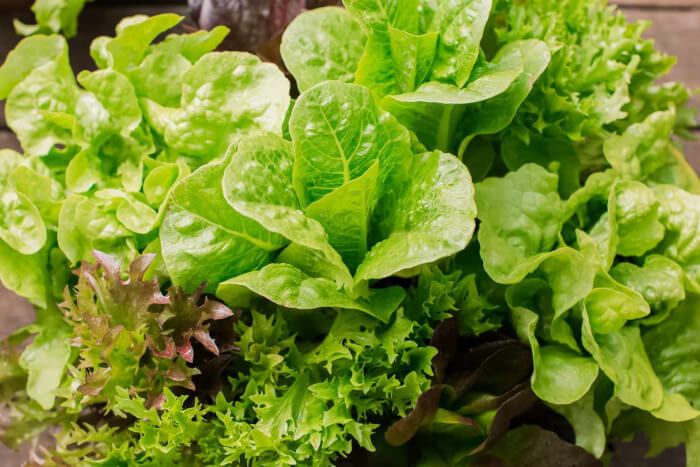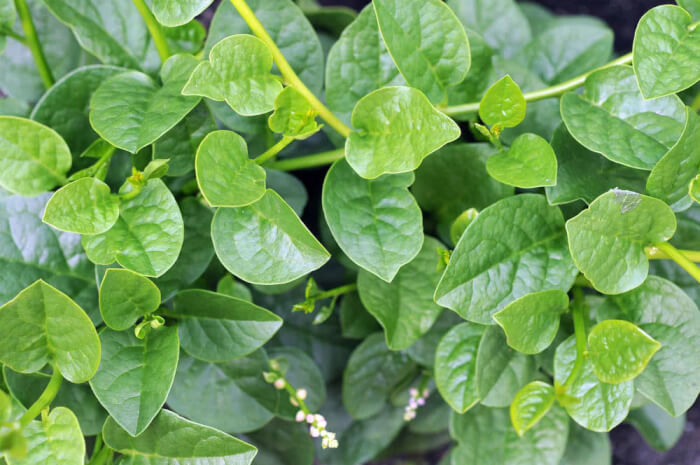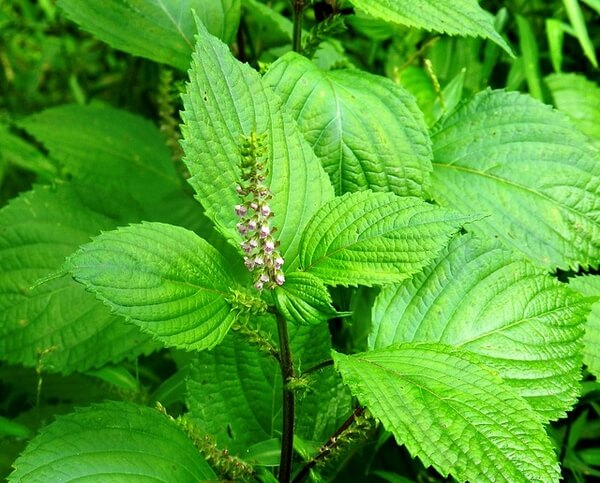The demand for self-growing veggies grows following COVID-19. Vegetables that are simple and quick to raise at home have recently gained popularity. However, it will take a while to cultivate vegetables if you start by planting specific kinds of seeds.
To focus on growing healthy plants, you must soak the seeds, wait a week for the plants to germinate, then trim the plants, and finally start eating vegetables after about 1.5 to 2 months.
However, you can easily grow 12 well-known vegetables listed below from cuttings to harvest. By repurposing the food plants found in the kitchen, you can grow a lot of spices and veggies with a little warm sunshine, a little perseverance, and a position with enough daylight.
Are you ready? Let’s check this list out with us!
#1. Fenugreek
 Source: AllThatGrows
Source: AllThatGrows
Botanical Name: Trigonella foenum-graecum
Features: Fenugreek (methi) plants grow fast. They take less than 30 days from seed to harvest. Besides, this simple-to-grow herb not only adds beauty to the garden but also has medical benefits, a unique flavor, and even improves the soil’s quality.
How to grow: Water your seeds after planting them in the ground. Make sure the soil is moist throughout. Any extra water should immediately drain away. Avoid overwatering the plant since damp soil might limit the plant’s growth.
#2. Arugula
 Source: HGTV
Source: HGTV
Botanical Name: Eruca sativa
Features: With age, the peppery, spicy flavor of the leaves turns bitter. This potent aroma and bitter flavor of this plant, which also reduces inflammation and helps protect from certain malignancies, are natural compounds of this plant. It has a significant amount of vitamin K, which is beneficial for your bones and could help avoid osteoporosis.
How to grow: Arugula develops quickly. It should be put in a sunny garden. The cooler days of spring or fall are suggested for it. Arugula needs rich soil to develop at its best just like any other leafy green, so it will thrive even more if you feed it with plant food.
#3. Green Onions
 Source: Curbed
Source: Curbed
Botanical Name: Allium Cepa
Features: Crisp and juicy green onions have a strong flavor that is grassy, sweet, and just a little bit sour. They also have calcium and vitamin A and are a great source of beta-carotene, folate, and vitamin C.
How to grow: Green onions, like the majority of vegetables, prefer full sun, so try to find a location that helps them receive at least 6 to 8 hours of direct sunlight daily. Fertile and well-draining soil is ideal, and they grow best in raised beds.
#4. Spinach
 Source: Gardener’s Path
Source: Gardener’s Path
Botanical Name: Spinacia Oleracea
Features: While lettuce also benefits from cool-season growing circumstances, spinach is more adaptable in terms of nutrition and whether it may be consumed raw or cooked. It is one of the best sources of vitamins A, B, and C and contains higher levels of iron, calcium, and vitamins than the majority of green leaves.
How to grow: Sow spinach seeds directly into the soil as soon as the ground reaches 40°F since spinach needs six weeks of cool weather from seeding to harvest.
#5. Pea Shoots
 Source: Gardener’s World
Source: Gardener’s World
Botanical Name: Spinacia Oleracea
Features: Pea shoots are fast-growing food that can be grown indoors on a windowsill or outside in the ground or in pots. Pea shoots are healthy and rich in vitamin C, as well as good amounts of vitamins A, B6, E, and K.
How to grow: Pea shoots can be raised in the ground or in containers with weed-free, well-prepared soil. For developing pea shoots, create a shallow trench that is 15-20 cm broad and 8–10 cm deep using a rake or draw hoe. If growing in pots, use a broad, shallow container that is between 8 and 10 cm deep, and firm it gently.
#6. Garden Cress
 Source: The Seed Collection
Source: The Seed Collection
Botanical Name: Lepidium Sativum
Features: Fresh cress is used as a salad green and sandwich filling. It’s a fast-growing, often weedy native of western Asia, is also widely grown, especially in its curl-leaved form, and the seedlings are used as a garnish. It is packed with nutrients, boosts bone, and supports the immune system.
How to grow: If put close to a window, microgreens can flourish indoors throughout the darkest months of the year, even in dim lighting. Warmer regions can generate microgreens in about 5-7 days, whilst colder climates need a longer growing period, about 2 weeks.
#7. Microgreens
 Source: Microgreens Corner
Source: Microgreens Corner
Typical Microgreens: Mustard Greens, Kale, Arugula, Radish Greens, Watercress, Peas, Cabbage, Basil.
Features: Microgreens are typically utilized as a fresh flavoring element in cuisine. The delicate, fresh appearance of microgreens provides elegance and dimension along with a variety of unique flavor components.
How to grow: Moisten the soil but do not overwater. Once the real leaves (not the seed leaves) start to sprout, the microgreens should be ready to harvest in about 2 weeks. Snip the microgreens with scissors just above the soil. Sadly, after the initial harvest, the microgreens won’t grow again. You’ll need fresh seeds and soil to grow more.
#8. Lettuce
 Source: The Spruce
Source: The Spruce
Botanical Name: Lactuca Sativa
Features: Most lettuce species are consumed raw, and they are frequently used as the foundation of green salads. Although the nutritional value of lettuce varies depending on the variety, it is usually a good source of vitamins K and A.
How to grow: A simple to cultivate annual vegetable is lettuce. When the temperature ranges from 60 to 70 degrees F, which is regarded as a spring and fall crop, lettuce thrives. Numerous kinds can be harvested as microgreens much sooner and some can mature in as little as 30 days.
#9. Water Spinach
 Source: Amazon
Source: Amazon
Botanical Name: Lactuca Sativa
Features: A mild, nutty flavor with vegetal, mildly sweet, and mineral undertones can be found in water spinach. Generally, young leaves and stems are picked and cooked to produce a sweeter and more tender finish.
How to grow: Water Spinach is available year-round, with a peak season in the summer through early fall. Use rich, loamy soil that has been compacted when planting water spinach in a container. Choose a container with a minimum depth and diameter of 12 inches.
Although the plant can thrive in either partial or full sunshine, it needs at least four hours of direct sunlight daily to produce additional leaves. Water the soil frequently to keep it moist.
#10. Malabar Spinach
 Source: Ugaoo
Source: Ugaoo
Botanical Name: Basella Alba
Features: Malabar spinach leaves are a good source of calcium, iron, and vitamins A, B, and C. They are a great source of fiber, high in antioxidants, and low in calories.
How to grow: This warm season vegetable should not be planted outdoors until a few weeks after the last threat of frost has passed since it is extremely frost-sensitive. Start seeding indoors six to eight weeks before the last frost. Seed germination should take about 3 weeks.
#11. Wild Pepper
 Source: Know Your Dillenia
Source: Know Your Dillenia
Botanical Name: Piper Sarmentosum
Features: The dried and ripened plants are utilized both as food and medicine. The leaves smell faintly of pepper and have a mildly bitter flavor. The leaves are used to treat cough, heartache, and bubonic plague as well as to bandage wounds and sores.
How to grow: Overall, the wild pepper plant needs a lot of water to flourish throughout its growing season. You’ll need to water early and frequently throughout the spring and summer to satisfy that increased water demand. You should water your wild pepper once or twice a week in the early stages of the growing season.
#12. Perilla Plants
 Source: North Carolina
Source: North Carolina
Botanical Name: Perilla Frutescens
Features: The lovely herb perilla has a wide range of applications. Perilla would be a wonderful addition to any herb garden, whether it is for culinary or medicinal use. This herb is a fantastic choice for use in the kitchen because of its distinctive flavor, which combines nuttiness and mint. Additionally, it works as a natural treatment for asthma and upset stomach.
How to grow: The time it takes for the seeds to sprout can range from one to three weeks. Like most other seeds, perilla seeds should be started indoors. Put them in grow trays filled with damp potting soil. Because the seeds need light to germinate, don’t cover them densely with dirt.
After planting, put the seeds somewhere warm to promote germination. Transplant the seeds outside when they are three inches tall.
